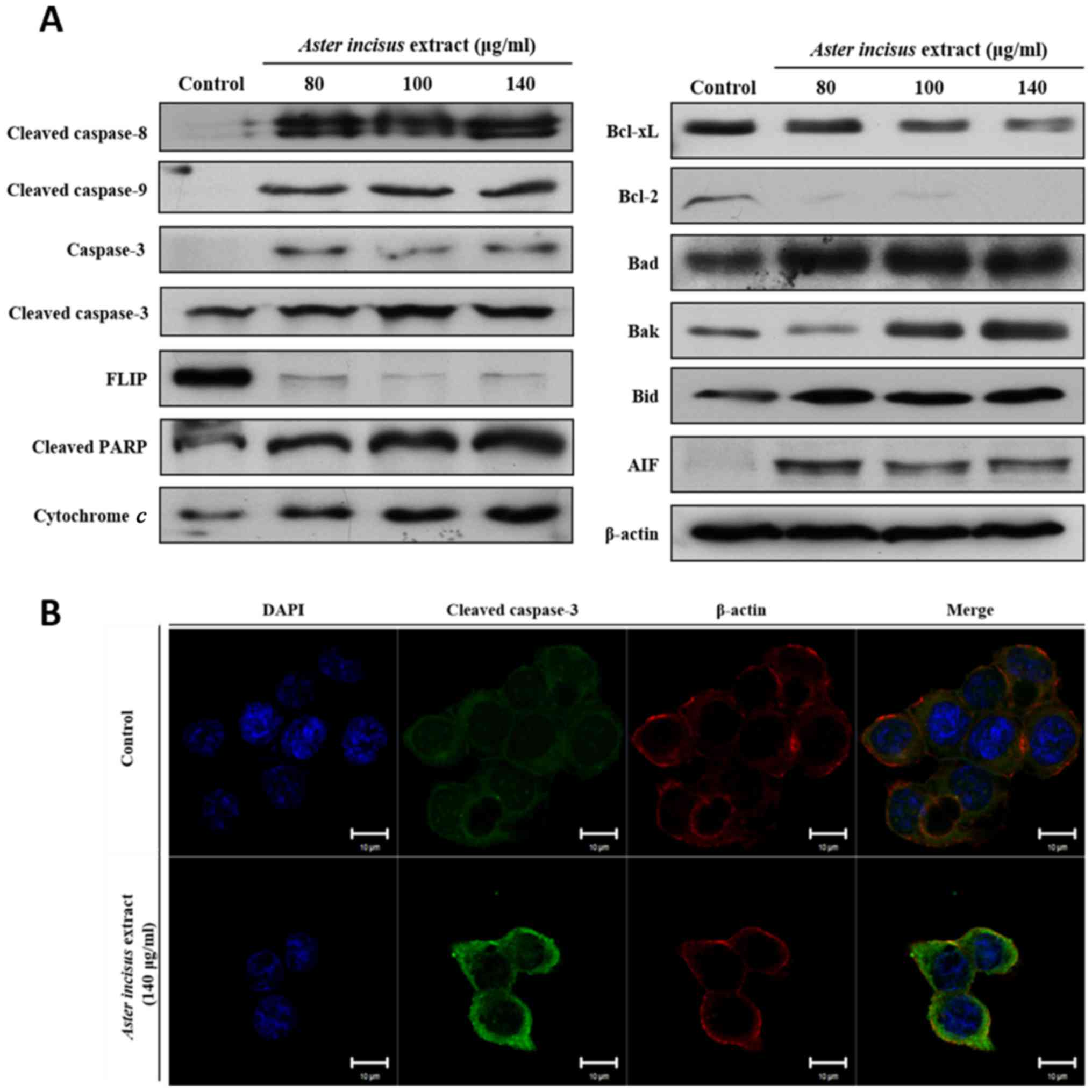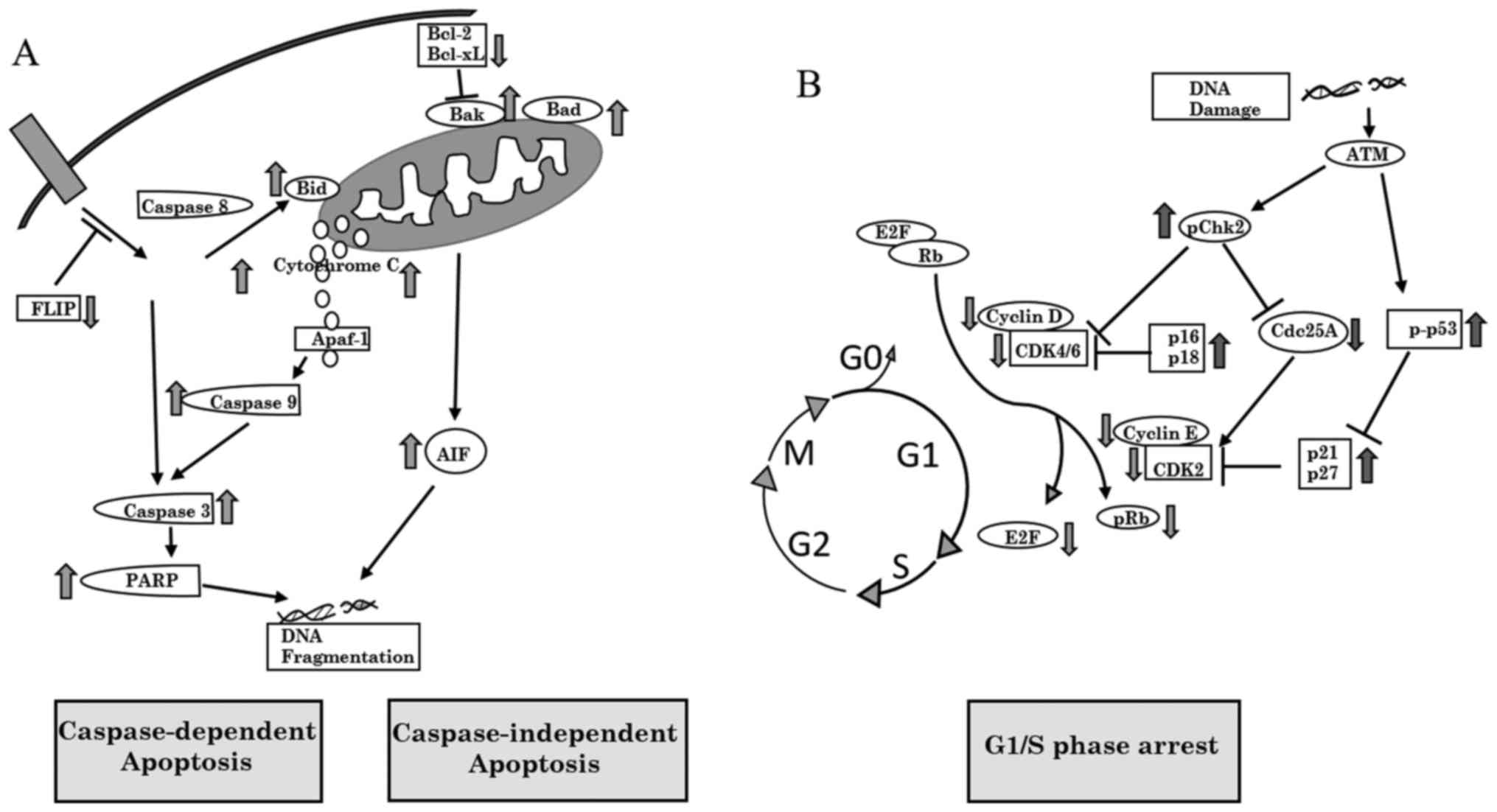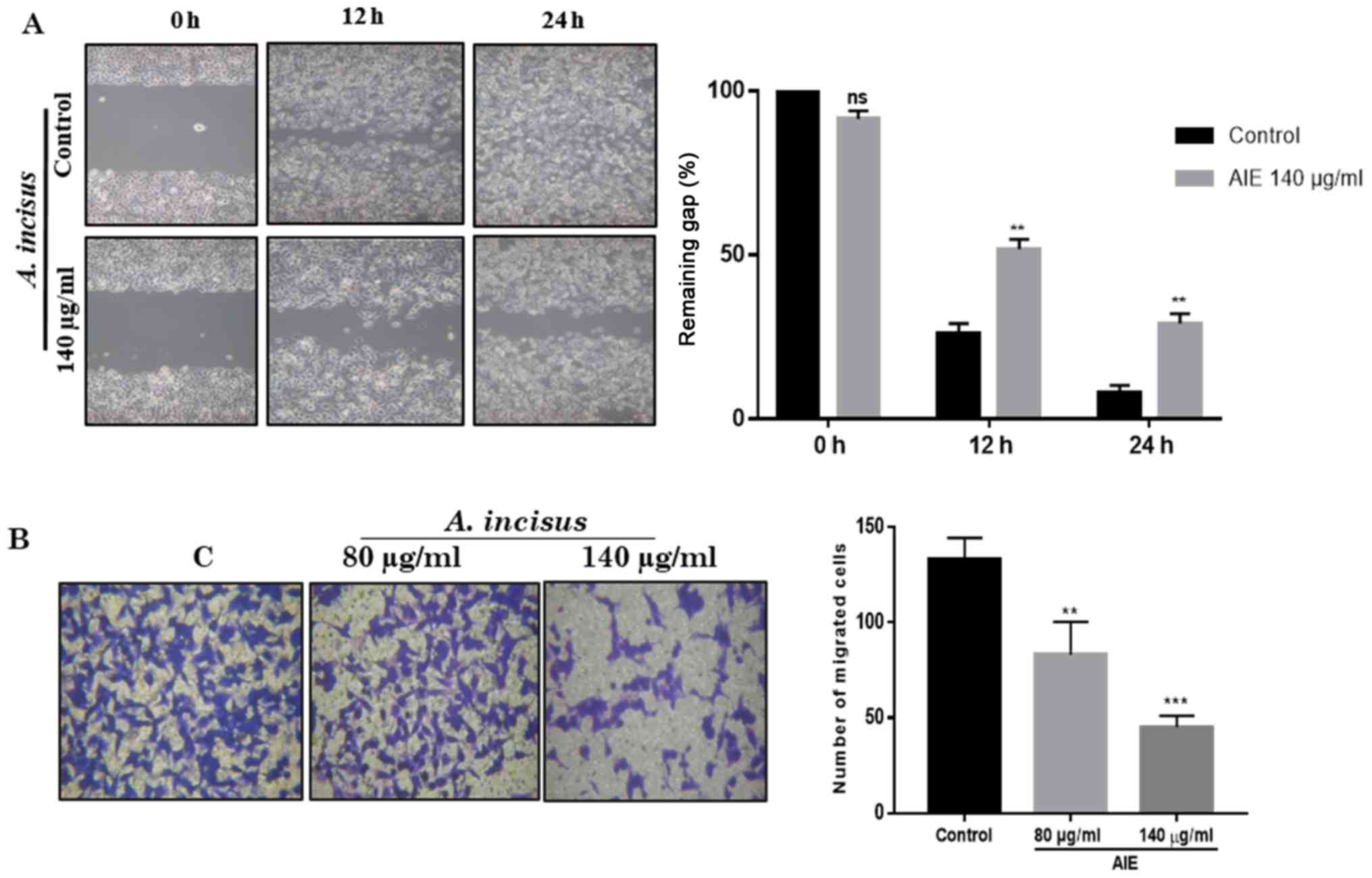|
1
|
Oh CM, Won YJ, Jung KW, Kong HJ, Cho H,
Lee JK, Lee DH and Lee KH; Community of Population-Based Regional
Cancer Registries: Cancer statistics in Korea: Incidence,
mortality, survival, and prevalence in 2013. Cancer Res Treat.
48:436–450. 2016. View Article : Google Scholar : PubMed/NCBI
|
|
2
|
Jung KW, Won YJ, Kong HJ and Lee ES;
Community of Population-Based Regional Cancer Registries: Cancer
Statistics in Korea: Incidence, mortality, survival, and prevalence
in 2015. Cancer Res Treat. 50:303–316. 2018. View Article : Google Scholar : PubMed/NCBI
|
|
3
|
World Health Organization: 2013, WHO
traditional medicine strategy. pp. 2014–2023, http://www.who.int/medicines/publications/traditional/trm_strategy14_23/en/.
Accessed April 28, 2018.
|
|
4
|
Ma JK-C, Chikwamba R, Sparrow P, Fischer
R, Mahoney R and Twyman RM: Plant-derived pharmaceuticals - the
road forward. Trends Plant Sci. 10:580–585. 2005. View Article : Google Scholar : PubMed/NCBI
|
|
5
|
Padmaja R, Arun PC, Prashanth D, Deepak M,
Amit A and Anjana M: Brine shrimp lethality bioassay of selected
Indian medicinal plants. Fitoterapia. 73:508–510. 2002. View Article : Google Scholar : PubMed/NCBI
|
|
6
|
Bais S: A phytopharmacological review on
an important medicinal plant: Leea indica. Cancer. 15:162013.
|
|
7
|
Cragg GM and Newman DJ: Plants as a source
of anti-cancer agents. J Ethnopharmacol. 100:72–79. 2005.
View Article : Google Scholar : PubMed/NCBI
|
|
8
|
Mann J: Natural products in cancer
chemotherapy: Past, present and future. Nat Rev Cancer. 2:143–148.
2002. View
Article : Google Scholar
|
|
9
|
Parkin DM, Bray F, Ferlay J and Pisani P:
Global cancer statistics, 2002. CA Cancer J Clin. 55:74–108. 2005.
View Article : Google Scholar : PubMed/NCBI
|
|
10
|
Jemal A, Bray F, Center MM, Ferlay J, Ward
E and Forman D: Global cancer statistics. CA Cancer J Clin.
61:69–90. 2011. View Article : Google Scholar : PubMed/NCBI
|
|
11
|
Siegel R, Ma J, Zou Z and Jemal A: Cancer
statistics, 2014. CA Cancer J Clin. 64:9–29. 2014. View Article : Google Scholar
|
|
12
|
Fock KM: Review article: The epidemiology
and prevention of gastric cancer. Aliment Pharmacol Ther.
40:250–260. 2014. View Article : Google Scholar : PubMed/NCBI
|
|
13
|
Satolli MA, Buffoni L, Spadi R and Roato
I: Gastric cancer: The times they are a-changin. World J
Gastrointest Oncol. 7:303–316. 2015. View Article : Google Scholar : PubMed/NCBI
|
|
14
|
Yoong J, Michael M and Leong T: Targeted
therapies for gastric cancer: Current status. Drugs. 71:1367–1384.
2011. View Article : Google Scholar : PubMed/NCBI
|
|
15
|
Cravo M, Fidalgo C, Garrido R, Rodrigues
T, Luz G, Palmela C, Santos M, Lopes F and Maio R: Towards curative
therapy in gastric cancer: Faraway, so close! . World J
Gastroenterol. 21:11609–11620. 2015. View Article : Google Scholar : PubMed/NCBI
|
|
16
|
Davidson M, Okines AF and Starling N:
Current and future therapies for advanced gastric cancer. Clin
Colorectal Cancer. 14:239–250. 2015. View Article : Google Scholar : PubMed/NCBI
|
|
17
|
Lee JH, Kim KM, Cheong JH and Noh SH:
Current management and future strategies of gastric cancer. Yonsei
Med J. 53:248–257. 2012. View Article : Google Scholar : PubMed/NCBI
|
|
18
|
Cragg GM, Grothaus PG and Newman DJ:
Impact of natural products on developing new anti-cancer agents.
Chem Rev. 109:3012–3043. 2009. View Article : Google Scholar : PubMed/NCBI
|
|
19
|
Yin SY, Wei WC, Jian FY and Yang NS:
Therapeutic applications of herbal medicines for cancer patients.
Evid Based Complement Alternat Med. 2013:3024262013. View Article : Google Scholar : PubMed/NCBI
|
|
20
|
Bishayee A: Editorial: Current advances in
cancer prevention and treatment by natural products. Curr Pharm
Biotechnol. 13:115–116. 2012. View Article : Google Scholar
|
|
21
|
Amin AR, Kucuk O, Khuri FR and Shin DM:
Perspectives for cancer prevention with natural compounds. J Clin
Oncol. 27:2712–2725. 2009. View Article : Google Scholar : PubMed/NCBI
|
|
22
|
Nakanishi M, Shimada M and Niida H:
Genetic instability in cancer cells by impaired cell cycle
checkpoints. Cancer Sci. 97:984–989. 2006. View Article : Google Scholar : PubMed/NCBI
|
|
23
|
Jin Z and El-Deiry WS: Overview of cell
death signaling pathways. Cancer Biol Ther. 4:139–163. 2005.
View Article : Google Scholar : PubMed/NCBI
|
|
24
|
Morgan DO: Principles of CDK regulation.
Nature. 374:131–134. 1995. View
Article : Google Scholar : PubMed/NCBI
|
|
25
|
Hassan M, Watari H, AbuAlmaaty A, Ohba Y
and Sakuragi N: Apoptosis and molecular targeting therapy in
cancer. BioMed Res Int. 2014:1508452014. View Article : Google Scholar : PubMed/NCBI
|
|
26
|
Cory S and Adams JM: The Bcl2 family:
Regulators of the cellular life-or-death switch. Nat Rev Cancer.
2:647–656. 2002. View
Article : Google Scholar : PubMed/NCBI
|
|
27
|
Langerak P and Russell P: Regulatory
networks integrating cell cycle control with DNA damage checkpoints
and double-strand break repair. Philos Trans R Soc Lond B Biol Sci.
366:3562–3571. 2011. View Article : Google Scholar : PubMed/NCBI
|
|
28
|
Al-Ejeh F, Kumar R, Wiegmans A, Lakhani
SR, Brown MP and Khanna KK: Harnessing the complexity of DNA-damage
response pathways to improve cancer treatment outcomes. Oncogene.
29:6085–6098. 2010. View Article : Google Scholar : PubMed/NCBI
|
|
29
|
Branzei D and Foiani M: Regulation of DNA
repair throughout the cell cycle. Nat Rev Mol Cell Biol. 9:297–308.
2008. View Article : Google Scholar : PubMed/NCBI
|
|
30
|
Jackson SP and Bartek J: The DNA-damage
response in human biology and disease. Nature. 461:1071–1078. 2009.
View Article : Google Scholar : PubMed/NCBI
|
|
31
|
Hu B, Wei-chen Ho, Li X, Ma L, Bai X, Liu
Q and Liu B: Aster tataricus attenuates the neuronal cell damage
and restores the cognitive functions in epileptic rat. Biomed Res
(Aligarh). 28:1189–1194. 2017.
|
|
32
|
Yao X, Dong X, Zhang H-S, Wang Y and
Lan-Yuzhu X-SL: Preventive effect of Aster tataricus on oxidative
stress and biomarker of renal function in rat fed with high fat
diet and sucrose diet. Biomed Res (Aligarh). 28:1647–1653.
2017.
|
|
33
|
Zhang HT, Tian M, He QW, Chi N, Xiu CM and
Wang YB: Effect of Aster tataricus on production of inflammatory
mediators in LPS stimulated rat astrocytoma cell line (C6) and
THP-1 cells. Saudi Pharm J. 25:370–375. 2017. View Article : Google Scholar : PubMed/NCBI
|
|
34
|
Wang R, Xiao S and Niu Z: Anti-cancer
activity of Aster tataricus on SCC-9 human oral squamous carcinoma.
Afr J Tradit Complement Altern Med. 14:142–147. 2017. View Article : Google Scholar :
|
|
35
|
Han MH, Jeong JS, Jeong JW, Choi SH, Kim
SO, Hong SH, Park C, Kim BW and Choi YH: Ethanol extracts of Aster
yomena (Kitam) Honda inhibit adipogenesis through the activation of
the AMPK signaling pathway in 3T3-L1 preadipocytes. Drug Discov
Ther. 11:281–287. 2017. View Article : Google Scholar : PubMed/NCBI
|
|
36
|
Choi JH, Kim DW, Park SE, Choi BS, Sapkota
K, Kim S and Kim SJ: Novel thrombolytic protease from edible and
medicinal plant Aster yomena (Kitam) Honda with anticoagulant
activity: Purification and partial characterization. J Biosci
Bioeng. 118:372–377. 2014. View Article : Google Scholar : PubMed/NCBI
|
|
37
|
Duarte B, Cabrita MT, Gameiro C, Matos AR,
Godinho R, Marques JC and Caçador I: Disentangling the
photochemical salinity tolerance in Aster tripolium L.: Connecting
biophysical traits with changes in fatty acid composition. Plant
Biol Stuttg. 19:239–248. 2017. View Article : Google Scholar
|
|
38
|
Kim SJ, Bang CY, Guo YR and Choung SY:
Anti-obesity effects of Aster spathulifolius extract in high-fat
diet-induced obese rats. J Med Food. 19:353–364. 2016. View Article : Google Scholar : PubMed/NCBI
|
|
39
|
Kantari C and Walczak H: Caspase-8 and
bid: Caught in the act between death receptors and mitochondria.
Biochim Biophys Acta. 1813:558–563. 2011. View Article : Google Scholar : PubMed/NCBI
|
|
40
|
Brunelle JK and Letai A: Control of
mitochondrial apoptosis by the Bcl-2 family. J Cell Sci.
122:437–441. 2009. View Article : Google Scholar : PubMed/NCBI
|
|
41
|
Parrish AB, Freel CD and Kornbluth S:
Cellular mechanisms controlling caspase activation and function.
Cold Spring Harb Perspect Biol. 5:a0086722013. View Article : Google Scholar : PubMed/NCBI
|
|
42
|
Redza-Dutordoir M and Averill-Bates DA:
Activation of apoptosis signalling pathways by reactive oxygen
species. Biochim Biophys Acta. 1863:2977–2992. 2016. View Article : Google Scholar : PubMed/NCBI
|
|
43
|
Kitazumi I and Tsukahara M: Regulation of
DNA fragmentation: The role of caspases and phosphorylation. FEBS
J. 278:427–441. 2011. View Article : Google Scholar
|
|
44
|
Cazal CM, Choosang K, Severino VG, Soares
MS, Sarria AL, Fernandes JB, Silva MF, Vieira PC, Pakkong P,
Almeida GM, et al: Evaluation of effect of triterpenes and
limonoids on cell growth, cell cycle and apoptosis in human tumor
cell line. Anticancer Agents Med Chem. 10:769–776. 2010. View Article : Google Scholar
|
|
45
|
Kastan MB and Bartek J: Cell-cycle
checkpoints and cancer. Nature. 432:316–323. 2004. View Article : Google Scholar : PubMed/NCBI
|
|
46
|
Malumbres M and Barbacid M: Cell cycle,
CDKs and cancer: A changing paradigm. Nat Rev Cancer. 9:153–166.
2009. View Article : Google Scholar : PubMed/NCBI
|
|
47
|
Hoshino R, Tanimura S, Watanabe K, Kataoka
T and Kohno M: Blockade of the extracellular signal-regulated
kinase pathway induces marked G1 cell cycle arrest and apoptosis in
tumor cells in which the pathway is constitutively activated:
Up-regulation of p27(Kip1). J Biol Chem. 276:2686–2692. 2001.
View Article : Google Scholar
|
|
48
|
Chen ZY and Istfan NW: Docosahexaenoic
acid, a major constituent of fish oil diets, prevents activation of
cyclin-dependent kinases and S-phase entry by serum stimulation in
HT-29 cells. Prostaglandins Leukot Essent Fatty Acids. 64:67–73.
2001. View Article : Google Scholar : PubMed/NCBI
|
|
49
|
Harbour JW and Dean DC: Rb function in
cell-cycle regulation and apoptosis. Nat Cell Biol. 2:E65–E67.
2000. View Article : Google Scholar : PubMed/NCBI
|
|
50
|
Agami R and Bernards R: Distinct
initiation and maintenance mechanisms cooperate to induce G1 cell
cycle arrest in response to DNA damage. Cell. 102:55–66. 2000.
View Article : Google Scholar : PubMed/NCBI
|
|
51
|
Petronelli A, Pannitteri G and Testa U:
Triterpenoids as new promising anticancer drugs. Anticancer Drugs.
20:880–892. 2009. View Article : Google Scholar : PubMed/NCBI
|
|
52
|
Wang Y, Zhou Y, Zhou H, Jia G, Liu J, Han
B, Cheng Z, Jiang H, Pan S and Sun B: Pristimerin causes G1 arrest,
induces apoptosis, and enhances the chemosensitivity to gemcitabine
in pancreatic cancer cells. PLoS One. 7:e438262012. View Article : Google Scholar : PubMed/NCBI
|
|
53
|
Wu G, Qian Z, Guo J, Hu D, Bao J, Xie J,
Xu W, Lu J, Chen X and Wang Y: Ganoderma lucidum extract induces G1
cell cycle arrest, and apoptosis in human breast cancer cells. Am J
Chin Med. 40:631–642. 2012. View Article : Google Scholar : PubMed/NCBI
|
|
54
|
Il Jung H, Jo MJ, Kim HR, Choi YH and Kim
GD: Extract of Saccharina japonica induces apoptosis companied by
cell cycle arrest and endoplasmic reticulum stress in SK-Hep1 human
hepatocellular carcinoma cells. Asian Pac J Cancer Prev.
15:2993–2999. 2014. View Article : Google Scholar : PubMed/NCBI
|
|
55
|
Banin S, Moyal L, Shieh S, Taya Y,
Anderson CW, Chessa L, Smorodinsky NI, Prives C, Reiss Y, Shiloh Y,
et al: Enhanced phosphorylation of p53 by ATM in response to DNA
damage. Science. 281:1674–1677. 1998. View Article : Google Scholar : PubMed/NCBI
|
|
56
|
Reinhardt HC and Schumacher B: The p53
network: Cellular and systemic DNA damage responses in aging and
cancer. Trends Genet. 28:128–136. 2012. View Article : Google Scholar : PubMed/NCBI
|
|
57
|
Qiu P, Guan H, Dong P, Li S, Ho CT, Pan
MH, McClements DJ and Xiao H: The p53-, Bax- and p21-dependent
inhibition of colon cancer cell growth by 5-hydroxy
polymethoxyflavones. Mol Nutr Food Res. 55:613–622. 2011.
View Article : Google Scholar : PubMed/NCBI
|
|
58
|
Bartek J and Lukas J: Chk1 and Chk2
kinases in checkpoint control and cancer. Cancer Cell. 3:421–429.
2003. View Article : Google Scholar : PubMed/NCBI
|



















